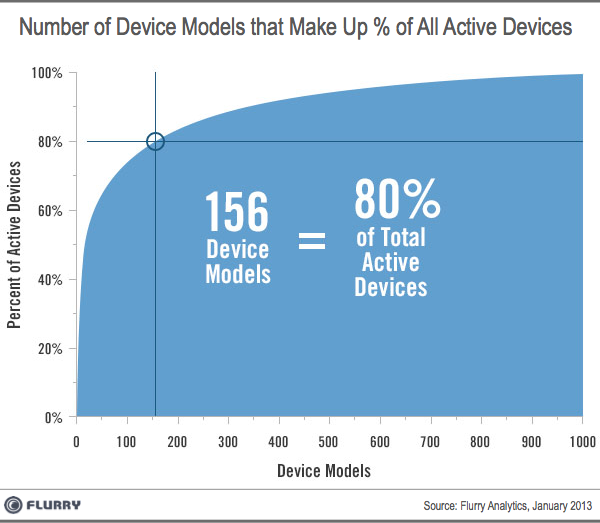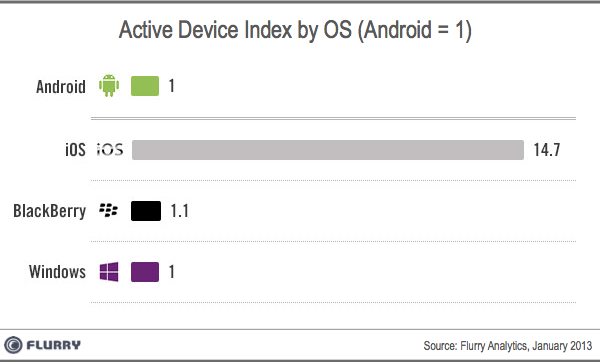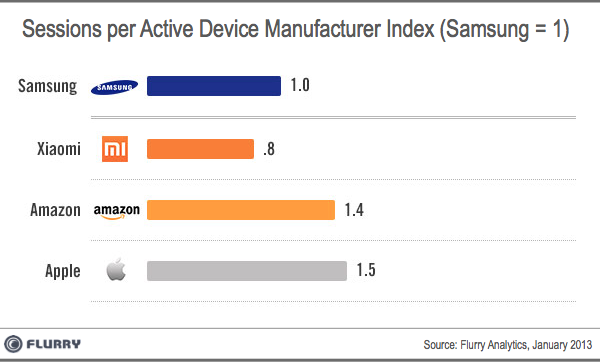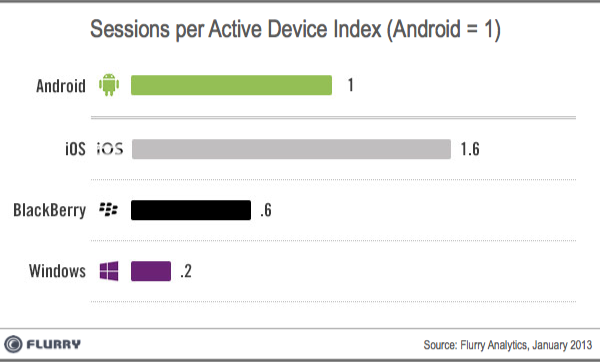Life difficulties of independent developers
Flurry’s latest research touches on the growing challenge of developing Android applications. It also addresses the undying Holivar iOS vs Android and why many novice developers prefer the apple platform.
Suppose you are an application developer and consider it necessary that your application be optimized to work on 80% of devices. How many different device models (including Kindle Fire, Galaxy SIII and others) do you think you need to support for this? The answer is 156.

Maybe 60% of all devices are enough for you, but you still have to support 37 different device models. Even 50% coverage means 18 different devices that should be supported.
If you move in the direction of expansion, then to cover 90% of all active devices, you will need support for 331 different models of smartphones. The superiority of iOS and Android platforms largely predetermined the number of necessary devices.
If you follow the 80/20 efficiency rule, the market will be fairly concentrated. Despite the fact that only 7% of devices are responsible for 80% of active users, the number of these devices is still not so small and poses serious challenges for developers.
')
Of course, developers can focus on a specific market segment, developing applications for a specific set of operating systems and subsequently a set of devices. But even with this narrowing of coverage, it may be necessary to adapt between different versions on the same platform: iOS 6.X / iOS 5.X, branching off Android versions; smartphones / tablets; an infinitely growing number of different screens, resolutions and aspect ratios.
In other words, application development, honed under the support of most devices, is becoming increasingly costly. At the same time, the lack of the ability to test and optimize for less popular devices can create the very negative user experience (which will certainly affect the ratings of your application), as well as the need to buy these devices to eliminate errors.
Such a serious market fragmentation has the potential to change the ecosystem of applications, creating more and more difficulties for small developers. For example, not every developer will be able to allow to constantly expand the list of supported and tested devices.
Moreover, according to a study conducted by Vision Mobile, the distribution of profits among developers is also far from normal: only a small proportion of application manufacturers earn more than $ 500 from one of their applications per month. The growing importance of supporting more and more devices makes it a little easier to understand these numbers. Not to mention the problems with the discoverer in the crowded market of mobile applications.
A reasonable question is, what do small developers do in this situation? One of the strategies can be to concentrate on the devices used by the majority. That is why in comparison with Android, developers often prefer iOS. The number of active users of devices on iOS is almost 15 times higher than on Android. If we consider the active users by manufacturer, the situation does not change.


We can say that this does not give a complete picture, because of the absolute figures about the number of active users, do not draw conclusions about the degree of use of these devices, so you should pay special attention to the number of sessions running from them.
And if we turn to this metric and view the devices from the point of view of session generation, this will again reduce the coverage: only 72 different devices are responsible for 80% of all sessions. But 72 devices are still quite a large number of devices, which, however, is significantly less than the number needed to cover 80% of the active devices mentioned at the very beginning.



With the growing competition in the device market, where each manufacturer is trying to maximize the range of devices, trying to reach the maximum number of different users, the difficulties for developers are growing. In addition to the problems associated with tests and optimization to support most devices, there are natural problems of growth: the market is becoming more saturated, competition is growing, negative feedback due to negative user experience is hitting harder, and the costs of distributing applications increase.
It is likely that the time is not far off when creative ideas will be harder to get across to the market, and small developers will begin to give way to large companies created to develop, design and distribute applications on a global scale. Well, quantity, as you know, does not always produce quality.
Suppose you are an application developer and consider it necessary that your application be optimized to work on 80% of devices. How many different device models (including Kindle Fire, Galaxy SIII and others) do you think you need to support for this? The answer is 156.

Maybe 60% of all devices are enough for you, but you still have to support 37 different device models. Even 50% coverage means 18 different devices that should be supported.
If you move in the direction of expansion, then to cover 90% of all active devices, you will need support for 331 different models of smartphones. The superiority of iOS and Android platforms largely predetermined the number of necessary devices.
In January, Flurry recorded 2,130 different devices with active users, 500 of them have a base of at least 175,000 active users.
If you follow the 80/20 efficiency rule, the market will be fairly concentrated. Despite the fact that only 7% of devices are responsible for 80% of active users, the number of these devices is still not so small and poses serious challenges for developers.
')
Of course, developers can focus on a specific market segment, developing applications for a specific set of operating systems and subsequently a set of devices. But even with this narrowing of coverage, it may be necessary to adapt between different versions on the same platform: iOS 6.X / iOS 5.X, branching off Android versions; smartphones / tablets; an infinitely growing number of different screens, resolutions and aspect ratios.
In other words, application development, honed under the support of most devices, is becoming increasingly costly. At the same time, the lack of the ability to test and optimize for less popular devices can create the very negative user experience (which will certainly affect the ratings of your application), as well as the need to buy these devices to eliminate errors.
Such a serious market fragmentation has the potential to change the ecosystem of applications, creating more and more difficulties for small developers. For example, not every developer will be able to allow to constantly expand the list of supported and tested devices.
Moreover, according to a study conducted by Vision Mobile, the distribution of profits among developers is also far from normal: only a small proportion of application manufacturers earn more than $ 500 from one of their applications per month. The growing importance of supporting more and more devices makes it a little easier to understand these numbers. Not to mention the problems with the discoverer in the crowded market of mobile applications.
A reasonable question is, what do small developers do in this situation? One of the strategies can be to concentrate on the devices used by the majority. That is why in comparison with Android, developers often prefer iOS. The number of active users of devices on iOS is almost 15 times higher than on Android. If we consider the active users by manufacturer, the situation does not change.


We can say that this does not give a complete picture, because of the absolute figures about the number of active users, do not draw conclusions about the degree of use of these devices, so you should pay special attention to the number of sessions running from them.
And if we turn to this metric and view the devices from the point of view of session generation, this will again reduce the coverage: only 72 different devices are responsible for 80% of all sessions. But 72 devices are still quite a large number of devices, which, however, is significantly less than the number needed to cover 80% of the active devices mentioned at the very beginning.



With the growing competition in the device market, where each manufacturer is trying to maximize the range of devices, trying to reach the maximum number of different users, the difficulties for developers are growing. In addition to the problems associated with tests and optimization to support most devices, there are natural problems of growth: the market is becoming more saturated, competition is growing, negative feedback due to negative user experience is hitting harder, and the costs of distributing applications increase.
It is likely that the time is not far off when creative ideas will be harder to get across to the market, and small developers will begin to give way to large companies created to develop, design and distribute applications on a global scale. Well, quantity, as you know, does not always produce quality.
Source: https://habr.com/ru/post/172409/
All Articles